The Snowy Egret is a medium-sized heron with slender, long bills and thin, long legs. Their necks are long and narrow, and set their small head well away from the body.
These birds are smaller than a Great Egret and larger than a Cattle Egret.
If you’re looking to find this bird, your best chance to see one is by taking a trip to the coast. Your chances are even higher if you can find tidal wetlands or mudflats. Scan the shallow waters for a medium-sized, slender white bird with black legs and bill. A closer look will allow you to see their yellow feet and facial skin.
On this page
Identification
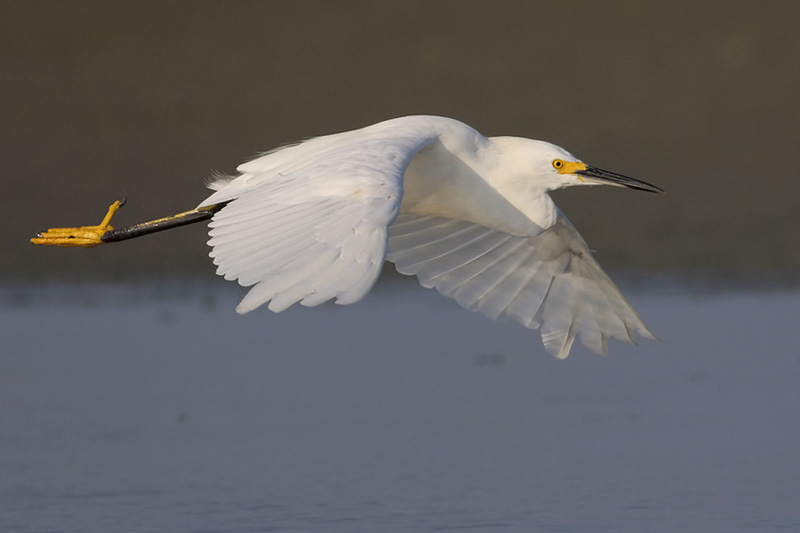
Snowy Egret
Adult male and adult female Snowy Egrets look identical.
They’re completely white, have yellow feet, black bills, and black legs. At the base of the bill, they have yellow skin.
Immature Snowy Egrets have duller legs that look more greenish. These birds are 22.1 to 26.0 inches (56 to 66 centimeters) long, weigh 13.1 ounces (370 grams), and have a wingspan of 39.4 inches (100 centimeters).
Food
Snowy Egrets primarily consume aquatic animals like frogs, fish, insects, crustaceans, and worms.
These birds will use their bright yellow feet to probe in the mud or paddle the water to round up prey. When ready, they’ll strike their prey with their bills. Snowy Egrets feed while hopping, standing, running, or walking. They may even sway their heads, vibrate their bills, or flick their wings to gather prey.
These birds have even been seen hovering while they forage. Snowy Egrets often search for food in tidal channels, salt marsh pools, tidal flats, swamps, freshwater marshes, lake edges, and ocean inlets. They usually prefer marine or brackish habitats with shallow water.
It’s also not uncommon to see them foraging with other water birds.
Nesting and Eggs
Male Snowy Egrets establish their nesting territory and choose where the nesting site will be. Nesting sites are usually amongst thick vegetation. The nest is commonly built in the outer or top branches of a woody tree, shrub, or vine.
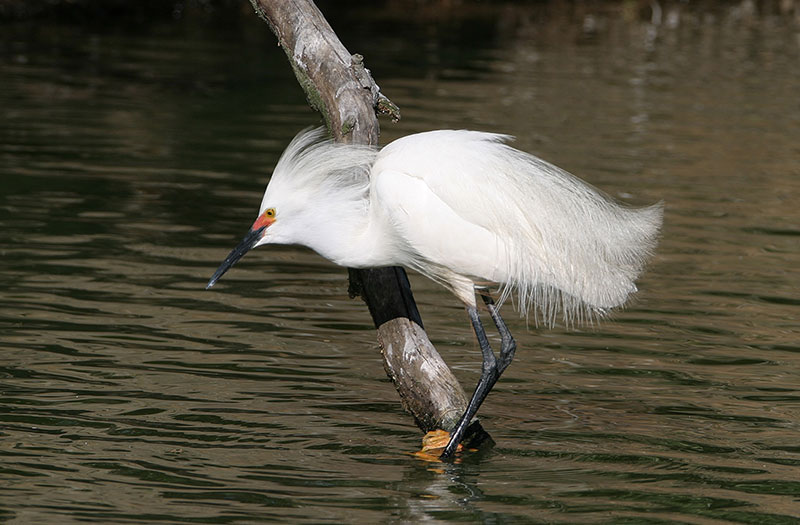
A typical Snowy Egret with thin, black bill, yellow in front of the eye and yellow feet. Pllumes on the head may be reudced or not visible. © Sam Crowe
The male Snowy Egret will start to make a nest before he even finds a mate. Once he finds his mate, she’ll take over and complete the nest with materials the male supplies. The nest is oval-shaped and shallow. It consists of loosely woven small sticks, twigs, Spanish moss, grasses, rushes, and sedges. It’s about 14 to 18 inches wide and 8 to 13 inches tall.
- The clutch size is 2 to 6 eggs.
- Egg length can be anywhere from 1.6 to 1.7 inches (4.1 to 4.4 centimeters).
- Egg width can be anywhere from 0.9 to 1.3 inches (2.3 to 3.3 centimeters).
- The incubation period is 24 to 25 days.
- The nestling period is 20 to 24 days.
- Eggs are a pale greenish blue.
Current Situation
Snowy Egrets had a stable population from the late 1960s to 2019.
They have an estimated breeding population of 2.1 million, meaning they’re a species of low concern.
In the late 1800s, large amounts of Snowy Egrets were killed for their breeding plumes. These breeding plumes were used to decorate women’s hats. Their populations rebounded and extended out from their original range once the killing for their breeding plume stopped. These birds can be found throughout the United States, except for some of the more northern states.
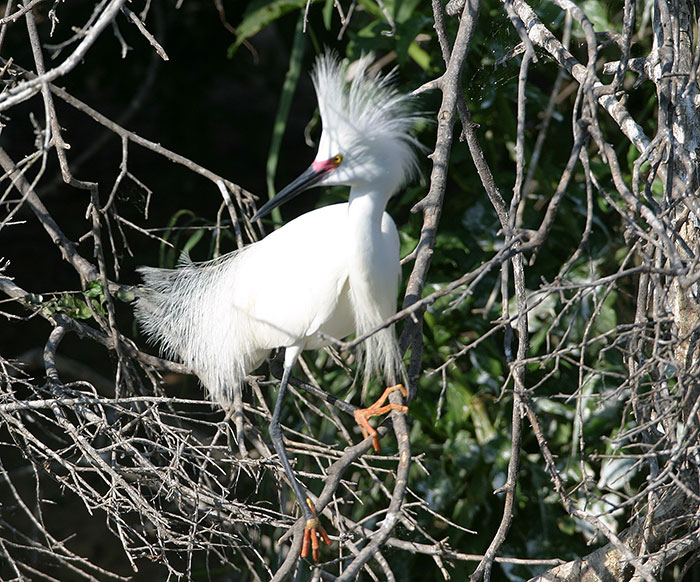
Snowy Egret in high breeding plumage. © Sam Crowe
However, Snowy Egrets still face the threat of habitat loss. More than 100,000,000 acres of U.S. wetlands have been drained since colonial times. These birds spend more time foraging than a lot of other herons; this makes them especially sensitive to the reduction of prey.
The future of this species, as well as others, depends on the conservation of coastal wetlands across North and South America.
Snowy Egrets nest in thick vegetation on colonies. These nesting sites are often in isolated places like marshes, barrier islands, swamps, dredge-spoil islands, and salt marsh islands. These birds don’t usually reuse a nesting site from a previous year; they’ll go and find a new one.
During the breeding season, Snowy Egrets feed in salt marshes, estuaries, tidal channels, mangroves, and shallow bays. They winter in mangroves, freshwater swamps, saltwater lagoons, temporary pools, and grassy ponds, and they’ll forage on wet fields, shallow reefs, and beaches.
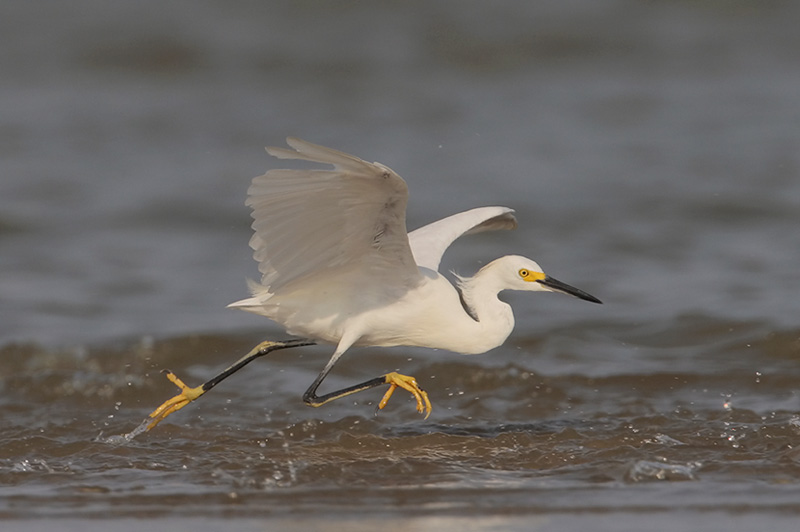
Facts
- Snowy Egrets develop wispy, long feathers on their heads, necks, and backs during the breeding season. In the late 1800s, these breeding plumes were valued at $32 per ounce. To put that into perspective for you, that was twice the price of gold at the time. As a result, many of these birds were killed for fashion until reforms were passed in the early 1900s.
- Snowy egrets are known to keep their nests very clean. They’ll always remove any debris like eggshells by tossing them outside of the nest.
- Snowy Egrets have been recorded mating with other heron species. The result of this is hybrid offspring. They have been known to mate with Cattle Egrets, Little Blue Herons, and Tricolored Herons.
- When breeding season comes around, Snowyy Egrets’ feet change from yellow to reddish-orange.
- The oldest recorded Snowy Egret lived to be at least 17 years and 7 months old. It was originally banded in 1970 in Colorado. In 1988, it was found in Mexico.
Similar Species
Snowy Egrets have features that are similar to other bird species. Here are some similar species:
Little Blue Heron – Both Snowy Egrets and juvenile Little Blue Herons are completely white. However, juvenile Little Blue Herons have thicker, gray-and-black bills. Additionally, their legs are a dull yellow-green. Snowy Egrets have slimmer, black bills and black legs.
Read more: Egret vs Heron
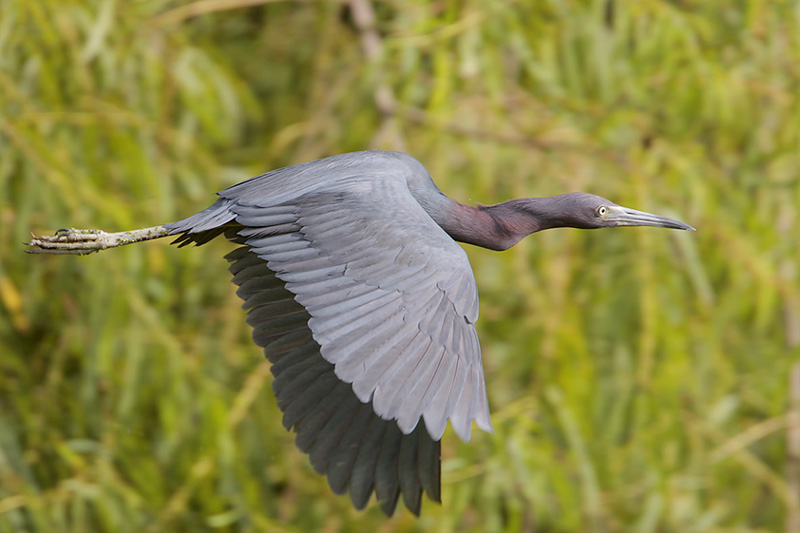
Little Blue Heron in flight
Cattle Egret – Snowy Egrets are larger than Cattle Egrets. Additionally, Cattle Egrets have bills that are thicker, shorter, and yellow, and their legs are yellow. Snowy Egrets have black bills and legs.
Related: What does finding a white feather mean?
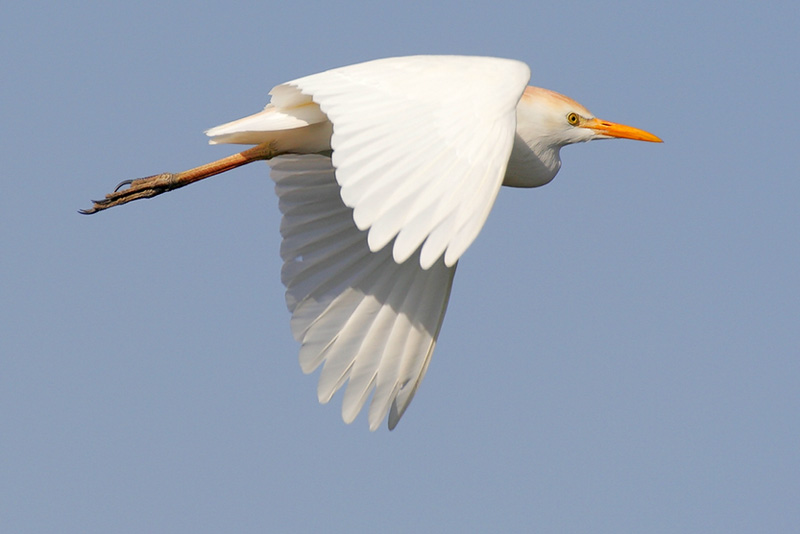
Cattle Egret. Photograph © Greg Lavaty.
Great Egret – Snowy Egrets are much smaller than Great Egrets. Snowy Egrets have black bills, while Great Egret bills are yellow. Additionally, Great Egrets fly slower and have deeper wingbeats.
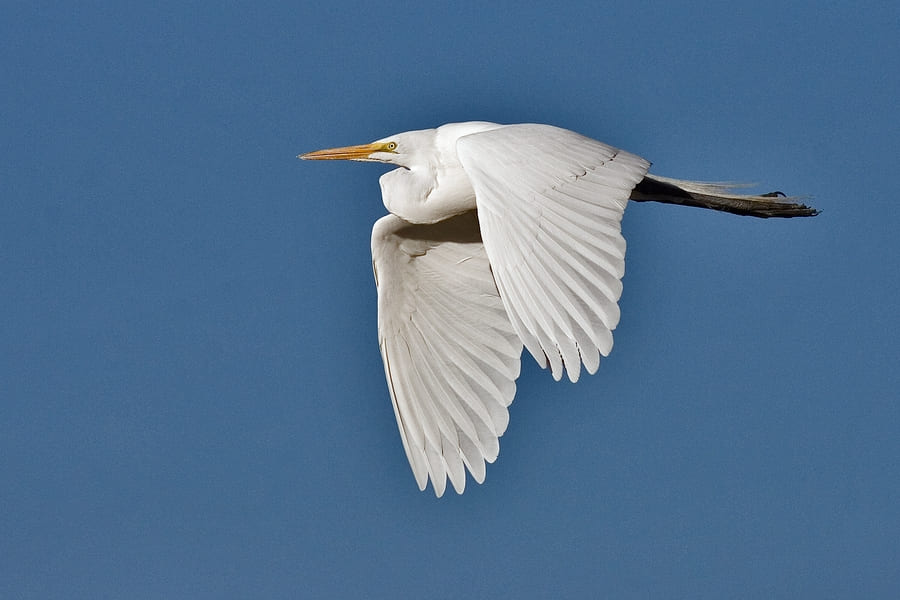
Great Egret. Photograph © Alan Wilson.
Reddish Egret – Adult breeding white morph Reddish Egrets are larger than Snowy Egrets and have two-toned pink-and-black bills.
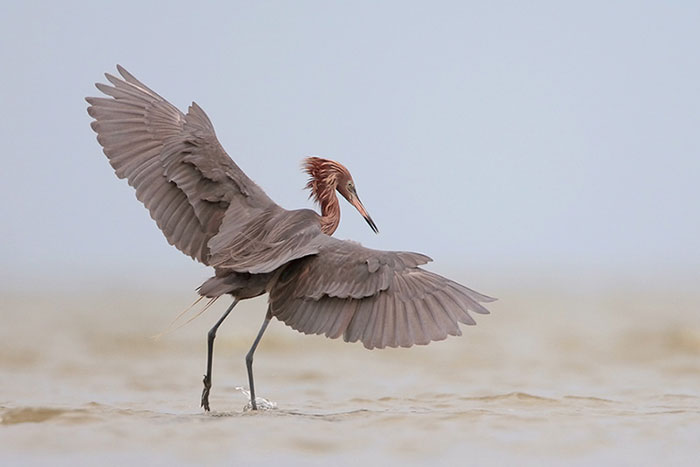
Reddish Egret
Frequently Asked Questions About Snowy Egrets
How do you identify a Snowy Egret?
You can identify a Snowy Egret by looking at its physical characteristics. Snowy Egrets are completely white, have yellow feet, black bills, and black legs. At the base of the bill, they have yellow skin. Immature Snowy Egrets’ legs look more greenish.
What is the difference between a Great White Heron and a Snowy Egret?
Snowy Egrets are much smaller than Great Egrets. Snowy Egrets have black bills, while Great Egret bills are yellow. Additionally, Great Egrets fly slower and have deeper wingbeats.
Are Snowy Egrets rare?
No, Snowy Egrets are not rare. They’re a bird that can be found across a good portion of North America and have an estimated breeding population of 2.1 million.
Where do Snowy Egrets live?
Snowy Egrets nest in thick vegetation in colonies. These nesting sites are often in isolated places like marshes, barrier islands, swamps, dredge-spoil islands, and salt marsh islands.
During the breeding season, Snowy Egrets feed in salt marshes, estuaries, tidal channels, mangroves, and shallow bays.
They winter in mangroves, freshwater swamps, saltwater lagoons, temporary pools, and grassy ponds, and they’ll forage on wet fields, shallow reefs, and beaches.

